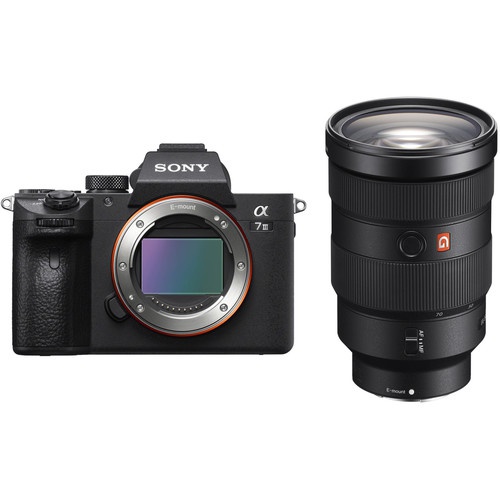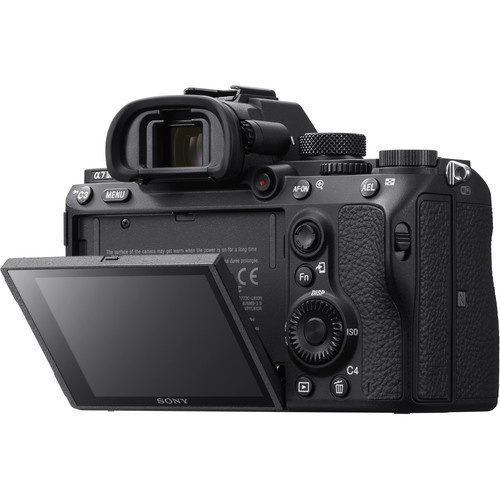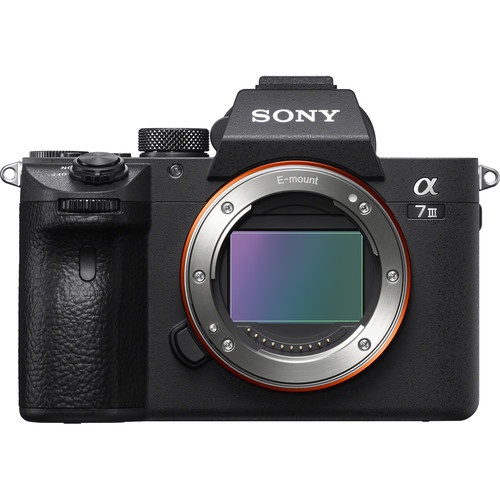
Sony a7 III Mirrorless Camera with 24-70mm f/2.8 Lens Kit
Inclusive of all taxes
View Shipping Details
 Free Shipping
Free Shipping 100% Secure Payments
100% Secure Payments 100% Genuine Product
100% Genuine ProductKnow more about this product
Why should I buy this?
Discover this product's exceptional qualities before buying.
Compare with other product
Comparing this product to any others that are comparable.
Get most popular reviews
Find product reviews for a better experience.
Where I can use this?
Understand the usability of the product.
| Lens Mount | Sony E |
| Sensor Type | 35.6 x 23.8 mm (Full-Frame) CMOS |
| Sensor Resolution | Actual: 25.3 Megapixel Effective: 24.2 Megapixel (6000 x 4000) |
| Crop Factor | None |
| Aspect Ratio | 3:2, 16:9 |
| Image File Format | JPEG, Raw |
| Bit Depth | 14-Bit |
| Image Stabilization | Sensor-Shift, 5-Axis |
An ideal starter bundle, the Sony a7 III Mirrorless Camera with 24-70mm f/2.8 Lens Kit pairs the versatile full-frame mirrorless body with the FE 24-70mm f/2.8 GM standard zoom lens.
Sony a7 III Mirrorless Camera
Distinguished by its updated sensor design, the Sony a7 III is a well-rounded camera suitable for both photo and video applications in a variety of working situations. Refined for improved speed and low-light performance, the full-frame 24.2MP Exmor R BSI CMOS sensor and BIONZ X image processor pair to realize an impressive 10 fps continuous shooting rate and improved autofocus performance for faster, more reliable subject tracking along with wide frame coverage. This updated Fast Hybrid AF System employs a combination of 693 phase-detection points and 425 contrast-detection areas for quicker acquirement of focus in a variety of lighting conditions, and also maintains focus on subjects more effectively. In addition to speed and AF, the processing improvements also help to realize greater image clarity and reduced noise throughout the sensitivity range from ISO 100-51200, which can further be expanded to ISO 50-204800. Video recording capabilities have also been extended for enhanced quality when recording UHD 4K video with the full width of the full-frame sensor to minimize moiré and aliasing. Additionally, benefitting both stills and video operation, the a7 III utilizes a 5-axis SteadyShot INSIDE sensor-shift image stabilization, which is now effective to minimize the appearance of camera shake by up to 5 stops.
Beyond just updates to the imaging system, the a7 III's body design has also been revised to include a rear 3.0" 922k-dot touchscreen LCD, which has a tilting design to better support working from high and low angles. A 2.36m-dot Tru-Finder OLED EVF is also featured for bright and clear eye-level monitoring. For greater shooting flexibility, dual SD memory card slots are now featured, and a larger NP-FZ100 battery is also employed to achieve up to approximately 710 shots per charge. Suiting the camera's use in trying conditions, the magnesium-alloy chassis and weather-sealing also render the a7 III dust- and moisture-resistant.
24.2MP Exmor R BSI CMOS Sensor and BIONZ X Image Processor
Featuring a back-illuminated design, the full-frame 24.2-megapixel Exmor R CMOS sensor works with the BIONZ X image processor to offer high-resolution stills and video while minimizing noise and improving speed. This sensor structure works with a gapless on-chip lens design and an anti-reflection coating to improve light collection and enhance detail. Also, the copper wiring layer dramatically improves data transmission speed for creating 14-bit, high-resolution stills with a native sensitivity range from ISO 100-51200, which can be further expanded to ISO 50-204800. Also, it enables internal UHD 4K video recording with a wide dynamic range using the full width of the full-frame sensor. The BIONZ X processor also works in conjunction with a high-speed front-end LSI to realize faster processing times along with the ability to capture an impressive 15-stop dynamic range at low sensitivity values.
The sensor and processor combination also avails fast continuous shooting at up to 10 fps at full resolution, for up to 177 consecutive frames, and with full-time AF/AE when working with either a mechanical shutter or an electronic shutter. If shooting in live view mode, a continuous shooting rate of up to 8 fps is also possible.
Fast Hybrid AF System
An evolved 4D FOCUS system now employs a combination of 693 phase-detection points, which cover approximately 93% of the frame, along with 425 contrast-detection areas for reliable and quick autofocus and subject tracking performance. This Fast Hybrid AF System now achieves twice the focusing speed and more reliable tracking compared to previous a7 models, as well as improved low-light focusing. The use of phase-detection points also enables the use of A-mount lenses via the optional LA-EA3 or LA-EA1 lens mount adapters with full continuous AF/AE tracking compatibility.
The apt focus system also lends itself to a variety of focusing functions for refined accuracy, including Lock-on AF, which maintains focus on moving subjects throughout the use of a configurable frame that is set over the desired moving subject, and Expand Flexible Spot, which employs neighboring focus points to retain focus on moving subjects even if the originally selected point loses focus. Additionally, Eye AF can be used to base focus on recognized subjects' eyes for portraits and is available in both AF-S and AF-C modes. Autofocus can also be used in conjunction with the Focus Magnifier function for critical focus when homing in on minute subject details. The rear touchscreen can also be used for Touch Focus control, and a Touchpad Focus Control mode lets you use the rear screen intuitively while keeping your eye to the viewfinder.
5-Axis SteadyShot INSIDE Image Stabilization
Packed into the robust a7 III is a 5-stop effective 5-axis SteadyShot INSIDE image stabilization system that compensates for five different types of camera shake encountered during handheld shooting of stills and video. This allows users to confidently use any lens, even adapted lenses, for critical imaging without encountering blur from camera shake.
For long focal lengths, the system will correct for pitch and yaw adjustments. Macro and high-magnification imagery, on the other hand, will benefit from the inclusion of horizontal and vertical shift compensation. All shooting styles will get usage out of the roll compensation. All 5 axes of stabilization will function at all times, even when used with third-party lenses and adapters or lenses with built-in optical stabilization.
UHD 4K Video Recording in XAVC S Format
Internal recording of UHD 4K movies is possible in multiple frame rates up to 30 fps and using 2.4x oversampling renders greater detail and full pixel readout is possible, that is void of pixel binning, for higher quality imagery with reduced moiré and aliasing. Full-frame 4K recording has also been dramatically improved for improved quality when working at mid to high sensitivities to permit full use of the entire sensor width. Full HD 1080p recording is also supported in frame rates up to 120 fps, and both resolutions utilize the 100 Mb/s XAVC S format contained within an MP4 wrapper with 4:2:0 sampling. The high-speed, 120 fps recording also enables 4x and 5x slow-motion movie recording with the frame rate set to either 30p or 24p. In addition to high-resolution internal recording, uncompressed HDMI output also enables the use of an optional external recorder for clean 4K recording with 4:2:2 sampling.
Affording extensive customizable color and gamma controls, the a7 III allows users to adjust the gamma, black level, knee, color level, and more. Also, users can use the same S-Log2 Gamma Curve that is found on high end Sony Cinema cameras that squeezes up to 1300% more dynamic range into the video signal then traditional REC709, for increased post-production flexibility. HLG (Hybrid Log-Gamma) support is also available, along with the BT.2020 color space, for recording within a wide color gamut and, in addition to S-Log2, S-Log3 is also available for producing an effective 14-stop dynamic range with increased grading control in the shadow to mid-tone regions of the image.
Body Design and Built-In Wi-Fi/Bluetooth
- An XGA OLED Tru-Finder EVF is featured, and has a 2.36m-dot resolution and 0.78x magnification for bright, clear viewing in high detail. This viewfinder design also affords the use of autofocus in the Focus Magnifier mode as well as improved focusing peaking to benefit manual focus operation.
- In addition to the EVF, a 3.0" 922k-dot rear LCD is also available, which has a touch panel design for intuitive operation and focusing control. The screen also tilts upward 107° and downward 41° to benefit working from high and low angles.
- Magnesium-alloy chassis assures rigidity, durability, and stability while remaining lightweight. The lens mount has also been improved to better support heavy lenses and the grip rigidity has been improved for more comfortable hand-holding.
- Weather-sealing has been employed to resist dust and moisture for reliable operation in harsh weather conditions.
- Using the NP-FZ100 battery, the a7 III has improved battery life and is now rated for approximately 710 shots per charge.
- Dual SD memory card slots allow for flexible file saving and handling, and can be configured to partition raw and JPEG files or can be used for overflow recording. One of the card slots is rated to support UHS-II memory cards.
- A USB 3.0 Type-C port has been added, in addition to a micro-USB port, for faster, more reliable tethering support. The USB Type-C connection allows the camera to be charged from the host power source while connected.
- Built-in Wi-Fi enables the a7 III to instantly share imagery to mobile devices for direct sharing online to social networking, via email, and to cloud storage sites. NFC (Near Field Communication) is also supported, which allows for one-touch connection between the camera and compatible mobile devices; no complex set-up is required. Once connected, the linked mobile device can also display a live view image on its screen and remotely control the camera's shutter.
- Bluetooth connectivity allows for location data acquisition.
Other Camera Features
- A Ratings function lets you assign star values, from 1-5, to images in-camera for faster editing and sorting at home during post-production.
- An advanced 1200-zone evaluative exposure metering sensor delivers consistent and accurate results using multi-segment, center-weighted, or spot metering modes.
- Highlight and Average metering modes helps avoid blown-out highlights and provide stable auto-exposure, respectively.
- Anti-flicker shooting automatically recognizes and times the shutter action to minimize the flicker effect for more consistent results on still images.
- Picture Effect modes: Posterization (Color), Posterization (B/W), Pop Color, Retro Photo, Partial Color (R/G/B/Y), High Contrast Monochrome, Toy Camera (Normal/Cool/Warm/Green/Magenta), and Soft High-Key.
- Creative Style modes: Standard, Vivid, Neutral, Clear, Deep, Light, Portrait, Landscape, Sunset, Night Scene, Autumn leaves, Black & White, Sepia, Style Box (1-6), (Contrast (-3 to +3 steps), Saturation (-3 to +3 steps), Sharpness (-3 to +3 steps).
UPC: 027242910768
Sony FE 24-70mm f/2.8 GM Lens
A fast, standard zoom favored for its versatility, the Sony FE 24-70mm f/2.8 GM is a wide-angle to short telephoto lens designed for E-mount mirrorless cameras. Featuring a constant f/2.8 maximum aperture, this lens maintains consistent performance throughout the zoom range and benefits working in low-light conditions and with selective focus techniques. Complementing the apt light-gathering capabilities is an equally impressive optical design, which incorporates three aspherical elements and two extra-low dispersion elements. One of the aspherical elements features an XA (extreme aspherical) designation, ensuring its refined surface precision and notable ability to minimize spherical aberrations throughout the zoom range. Additionally, a Nano AR Coating has been applied to individual elements to significantly minimize lens flare and ghosting for increased contrast and color neutrality. Pairing a sophisticated optical design and versatile speed, this standard zoom is well-suited for use in a wide array of environments and lighting conditions.
Beyond the attributes of the lens system itself, this 24-70mm is also characterized by a Direct Drive SSM (Super Sonic wave Motor) system that provides fast, quiet AF performance as well as responsive manual focus handling. The lens is also dust- and moisture-sealed, to permit working in inclement weather conditions, and nuanced details, such as a focus hold button and rubberized control dials, further the intuitiveness in handling.
As part of Sony's esteemed G Master series, this lens is designed to achieve notably high resolution and sharpness through the correction of a wide variety of spherical and chromatic aberrations. Additionally, these lenses feature robust and intuitive-to-handle physical designs to benefit both photography and cine applications.
Covering wide-angle to portrait-length perspectives, this standard 24-70mm zoom is designed for full-frame E-mount mirrorless cameras and is also compatible with APS-C models, where it will provide a 36-105mm equivalent focal length range.
Constant f/2.8 maximum aperture maintains consistent performance from wide-angle to telephoto focal length positions and also contributes to greater selective focus control.
Of the three aspherical elements incorporated in the lens design, one is an XA element with superior surface precision to effectively reduce astigmatism, field curvature, coma, and other monochromatic aberrations from imagery.
One extra-low dispersion element and one Super ED element are featured in the lens design and help to control chromatic aberrations and reduce color fringing for increased clarity and color fidelity.
A Nano AR Coating has been applied to reduce surface reflections, flare, and ghosting for increased contrast and color rendering in strong lighting conditions.
A Direct Drive Super Sonic wave AF motor and internal focus mechanism provide quick, quiet, and precise autofocus performance and also contribute to more natural, intuitive manual focus control.
A focus hold button and AF/MF switch are present on the lens barrel for intuitive tactile control and rapid access to select settings.
A dust- and moisture-sealed design better permits working in inclement conditions and rubberized control rings benefit handling in colder temperatures.
Rounded nine-blade diaphragm contributes to a pleasing bokeh quality when employing selective focus techniques.
- 24MP Full-Frame Exmor R BSI CMOS Sensor
- BIONZ X Image Processor & Front-End LSI
- 693-Point Hybrid AF System
- UHD 4K30p Video with HLG & S-Log3 Gammas





